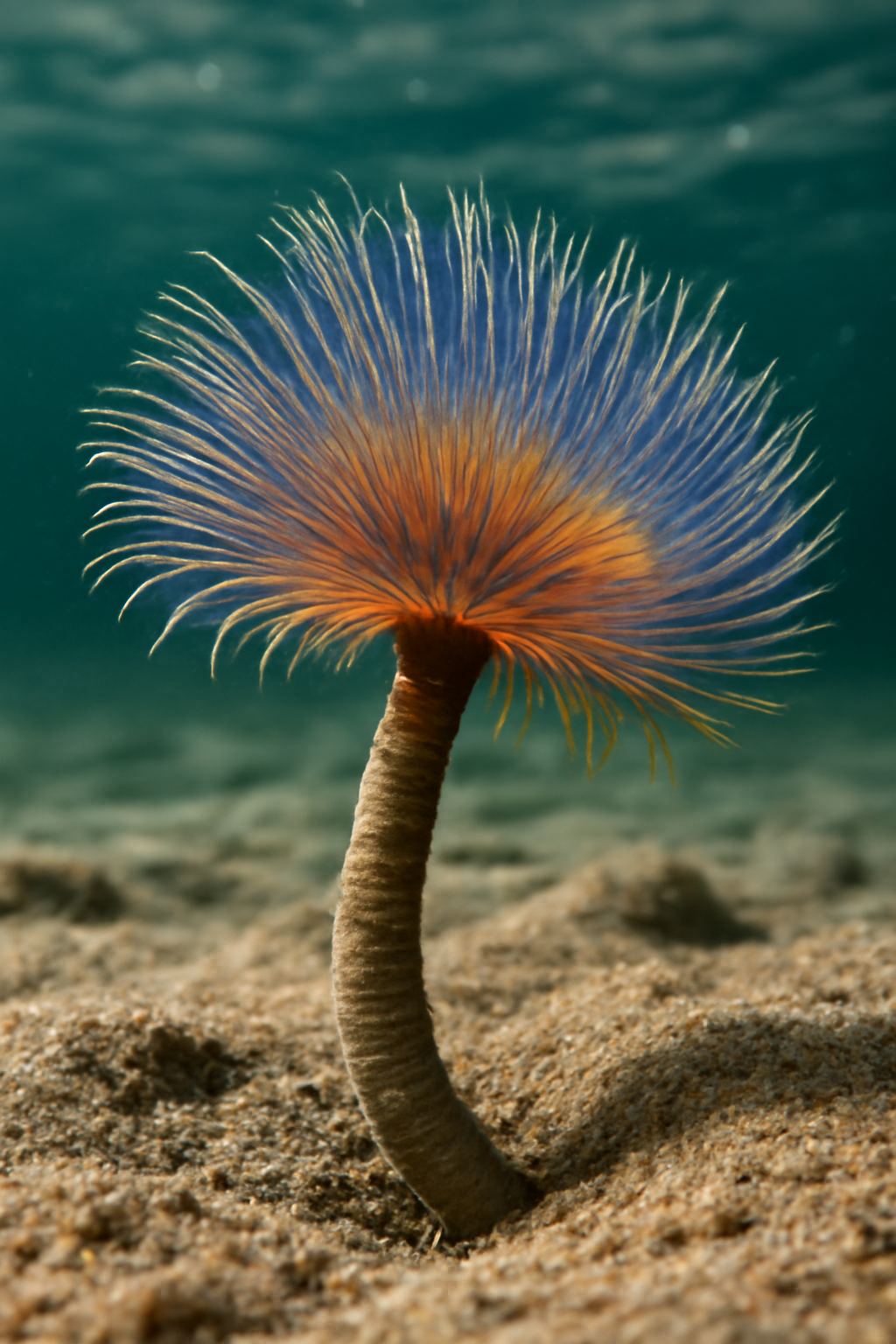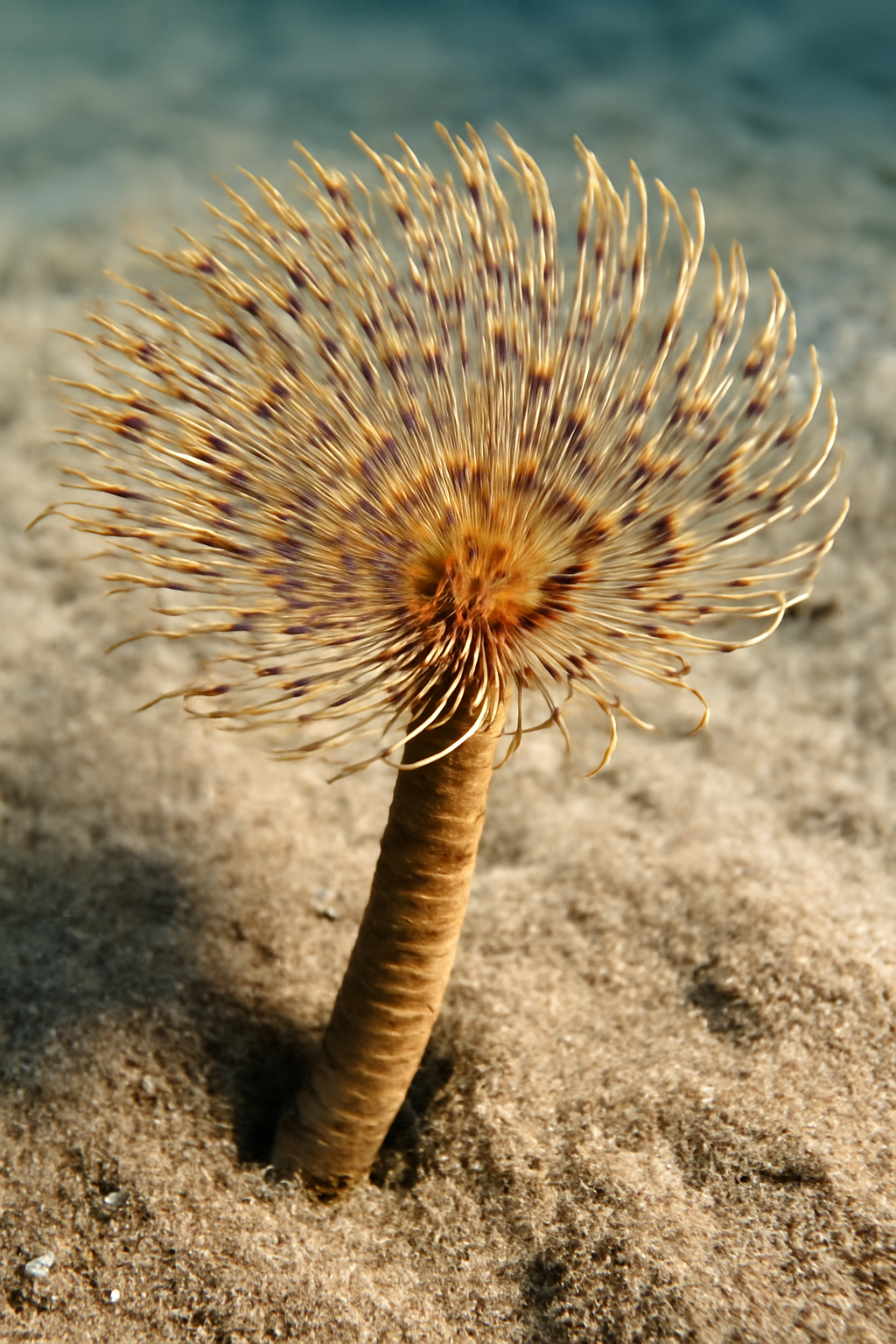Sabella and Parasabella: The Marine Feather Duster Worms – Biology, Morphology, Habitat, and Ecological Significance
Sabella and Parasabella are genera of marine polychaete worms belonging to the family Sabellidae, commonly known as feather duster worms due to their distinct fan-like radioles that protrude from their tubes. These worms are filter feeders inhabiting marine sediments and rocky, sandy substrates worldwide. Their delicate, feathery crowns are both spectacular and functional, used for capturing plankton and small organic particles from flowing seawater. Sabella and Parasabella species have complex tubes made from mucus and sediment particles, and their unique body structures and ecological roles make them subjects of interest in marine biology.
Classification of Sabella or Parasabella
| Taxonomic Rank | Name | Characteristics |
|---|---|---|
| Kingdom | Animalia | Multicellular eukaryotic organisms |
| Phylum | Annelida | Segmented worms with true coelom and metamerism |
| Class | Polychaeta | Marine bristle worms with parapodia |
| Order | Canalipalpata | Sedentary polychaetes with grooved palps |
| Family | Sabellidae | Feather duster worms with radioles used for filter feeding |
| Genus | Sabella / Parasabella | Tube-dwelling marine annelids with distinctive radiolar crowns |

Habit and Habitat
Sabella and Parasabella worms are sedentary filter feeders that inhabit tubes they build and live within. These tubes are often made of mucus and sediment particles, sometimes reinforced with calcareous materials. They project from sediment surfaces such as sand, mud, or gravel, attaching also to rocks, shells, or man-made structures like docks and marinas.
The worms extend their fan-like crowns of radioles through tube openings to capture plankton and suspended organic particles. These crowns can be swiftly retracted into the tubes when the animal senses threats such as predators or environmental disturbances.
Sabellids are found from intertidal zones down to significant depths in temperate and tropical seas, with diversity depending on substrate and water conditions. The two genera are usually associated with relatively stable benthic environments where slow water currents allow effective filter feeding.
Geographical Distribution
Sabella and Parasabella species are found worldwide, distributed among temperate and tropical marine regions. Sabella spallanzanii, known as the Mediterranean fanworm, is native to the northeastern Atlantic Ocean and Mediterranean Sea but has also spread to other regions due to shipping and aquaculture activities. Parasabella species have more restricted ranges but are well-documented in temperate coastal waters such as the northeastern Pacific and northeastern Atlantic.
General Characteristics
- Commonly called as ‘peacock worm’
- Animal lives in upright tube, made up of sand grains glued together.
- Body is divided into small head, a trunk and abdomen.
- Head is constituted by the prostomium, which contains several gill filaments or feathery tentacles which are modified palps. Each tentacle has 2 rows of small pinnules having mucus-secreting glands.
- Trunk region has 8 segments. First segment is called as peristomium which is collar-like having large ventral gland shield to secrete mucus. Peristomium has notopodium and setae, . but no neuropodium.
- The rest seven segments have normal each consisting of a notopodium with normal setae and a neuropodium with small bent setae called crochets or uncini.
- Abdomen is the largest part. A dorsal faecal groove extends ventral side parapodia,
- Sabella. from mouth to anus. It curves down in the last trunk segment to Parasabella is another allied form.
- In this species gill filaments are long and the slender peristomium is raised and reflexed to form a collar around the gills which is notched dorsally.
- Body Form: Elongated and segmented, with a soft body protected by a tube.
- Tube: Flexible, smooth, and sometimes leathery, projecting from benthic substrates.
- Radiolar Crown: Two-layered, feathery tentacles arranged in semi-circular fans used for suspension feeding.
- Radioles: May vary in color, often banded in shades of orange, purple, white, or pale grey, sometimes with spots.
- Sensory Structures: Radioles have long flanges and lamellae aiding in particle capture.
- Chaetae: Small, slender, distributed on thoracic and abdominal parapodia; uncini embedded in rows.
- Head: Modified prostomium and peristomium into an anterior collar protecting the crown.
- Size: Typically up to 30 cm length, tubes projecting several centimeters above substrate.
- Reproductive Features: Many species are dioecious; some demonstrate hermaphroditism.

Special Features
- Feather Duster Adaptation: The elaborate radiolar crowns increase surface area for filtration and provide respiratory functions.
- Rapid Retraction Ability: Radiolar crowns retract quickly to avoid predation.
- Tube Construction: Tubes built from secreted mucus and sediment particles, providing protection and structural support.
- Chaetal Diversity: Different chaetae types ensure efficient anchoring and movement within the tube.
- Tentacle Flanges: Enhances filtering efficiency by increasing water flow and particle trapping.
- Commensalism: Tubes may harbor epibionts such as algae and small invertebrates.
Identification
- Tube shape and composition.
- Radiolar crown arrangement and coloration patterns.
- Morphology of chaetae, particularly uncini and thoracic parapodia.
- Size and shape of prostomial structures.
- Detailed microscopic examination is used for species-level identification.
- Molecular and genetic analysis increasingly supplement traditional taxonomy.

Life Cycle and Reproduction
Sabellid worms reproduce sexually with separate sexes, releasing sperm and eggs into the water column for external fertilization. Some species exhibit epitoky, where parts of the body transform for pelagic reproduction and larval dispersal. The resulting trochophore larvae are planktonic and eventually settle to the seabed to grow into tube-dwelling adults.
Species like Parasabella fullo show hermaphroditism and brood eggs around the base of their tube, sometimes displaying vivipary. Juveniles develop branchiae and construct protective tubes early in life. Life cycles are influenced by environmental factors such as temperature, salinity, and food availability.
Ecological Role and Importance
- Filter Feeders: Play key roles in cleaning the water column by removing suspended particles including plankton and detritus.
- Sediment Stabilization: Tubes bind sediment particles, reducing erosion.
- Food Source: Serve as prey for fish, crustaceans, and other marine predators.
- Biodiversity Support: Provide microhabitats for epibionts and small invertebrates.
- Environmental Indicators: Their presence and abundance are used to assess water and sediment quality in ecological monitoring.
References
- https://en.wikipedia.org/wiki/Sabella_(annelid)
- https://en.wikipedia.org/wiki/Sabella_spallanzanii
- http://www.marinespecies.org/aphia.php?p=taxdetails&id=129549
- https://www.inaturalist.org/taxa/338012-Sabella-spallanzanii
- https://invasions.si.edu/nemesis/species_summary/-994
- https://www.marlin.ac.uk/species/detail/1717
- https://www.britannica.com/animal/Sabellida
- https://animaldiversity.org/accounts/Sabella/classification/
- https://www.marinespecies.org/aphia.php?p=taxdetails&id=130969
- https://www.iucngisd.org/gisd/species.php?sc=1046
